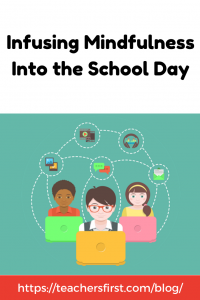“The best cure for the body is a quiet mind.”
-Napoleon Bonaparte
Imagine the possibilities – – –
What if our teachers approached each day, each class period, with a quiet mind?
What if our students began each day, each lesson, with a quiet mind?
What if our administrators approached each classroom observation or interaction with a student with a quiet mind?
 As you ponder your answers to the rhetorical questions above, let’s analyze Bonaparte’s quote. What exactly does a “quiet mind” mean, why is it important, and how can I work to achieve it in my own professional (and personal) life and assist in the development of it in my students? That brings me to a conversation about the integration of mindfulness into schools. Kids these days (and probably adults for that matter) are more stressed and anxious than ever. So, how can mindfulness restore a sense of management and control?
As you ponder your answers to the rhetorical questions above, let’s analyze Bonaparte’s quote. What exactly does a “quiet mind” mean, why is it important, and how can I work to achieve it in my own professional (and personal) life and assist in the development of it in my students? That brings me to a conversation about the integration of mindfulness into schools. Kids these days (and probably adults for that matter) are more stressed and anxious than ever. So, how can mindfulness restore a sense of management and control?
Mindfulness is defined as a quality or state of being conscious of something and awareness of the present moment. Educators know that children learn best when they are in a comfortable, safe, and relaxed environment. However, it’s important to note that structure must still exist. So, how do we integrate mindfulness into our classrooms you ask? Read on for some practical and easy ways to focus on social and emotional learning and create a calm and productive classroom at any level.
- Lead a “mindful moment”.
Start your day or lesson with a “mindful moment”, where you ask students to focus on gratitude silently. Then, ask students to share what they’re grateful for at the present moment or one compliment about the person beside them. This is an easy and effective way to start the day with a positive and grateful attitude which, in turn, facilitates students’ ability to be present and ready for learning. - Try mindfulness through breath or a quiet brain break.
Use this throughout the school day or class period to help with transitions, before assessments, or during difficult situations. A quiet brain break could be coloring (older kids love adult coloring books!), journaling, drawing, calming music, or sensory fidgets. - Circle up.
Classroom circles can be a powerful practice to promote mindfulness, restorative practices, communication, and compassion. Use circles to conduct a class meeting, for brief check-in, or to start or end the day/class period. Students can sit or stand, whatever works for your space.
As you start to feel more comfortable with the idea of mindfulness, you can work to incorporate more into your daily classroom routine. We owe it to our students to create a classroom environment that is calm, empathetic and allows students to be ready and present for learning.
Resources:

